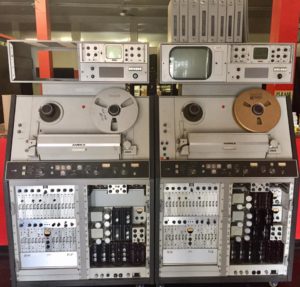
Next time you click on a YouTube link, think about what it took to play a video just a few decades ago. Pictured above is a pair of Ampex VR1200 2-inch quadruplex video tape recorders. If you wanted to record or play broadcast quality video (which wasn’t so great back in the 1960s and ’70’s), you needed one of these beasts.
The machine needed a constant supply of compressed air to keep the videotape in proper contact with it’s rapidly spinning heads. To play a program, the operator would heave a 20-lb reel of 2″ video tape onto the feed hub, thread the tape through the machine and onto the take-up reel.
Next he’d spend several minutes playing back color bars off the tape, viewing the signal on a waveform oscilloscope, while tweaking dozens of tiny knobs with a little screwdriver (called a tweaker), optimizing the machine’s settings for the signal recorded on the tape. After that painstaking process, he’d cue the tape up to the start of the program, and then back it up exactly seven seconds, using the machine’s time counter. Why? Because it took up to seven seconds for the VTR to “lock up” or play the video with enough stability to see a clean picture. So when it came time to air a program, the operator would have to start playback exactly seven seconds before the program was to appear, and the switch to the machine at the program’s start time.